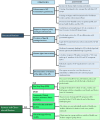Ensuring equitable access to quality HIV care for affected populations in complex sociocultural settings: Lessons from Nigeria
- PMID: 40367072
- PMCID: PMC12077709
- DOI: 10.1371/journal.pone.0319807
Ensuring equitable access to quality HIV care for affected populations in complex sociocultural settings: Lessons from Nigeria
Abstract
Background: HIV infection remains one of the major diseases of public health importance globally with an estimated 40.4 million deaths and 39 million people living with the virus by 2022. About 40 countries are on track to achieve a 95% reduction in AIDS-related mortality by 2030. This progress is however challenged by sub-optimal progress among affected populations (AP), also known as key populations (AP). Society for Family Health (SFH), with about 3 decades of experiences in AP program present in this paper an account of key strategies and innovations in adapting its service provisioning efforts to rapidly changing socio-cultural and political barriers to service delivery among AP in northern Nigeria.
Methods: SFH is an indigenous nonprofit, non-political, non-governmental organization in Nigeria that has pioneered HIV interventions among AP across most parts of Nigeria. SFH has successfully tailored its interventions to the unique cultural and religious diversity of Nigeria. The predominantly Islamic-orientated population in the northern part of the country and the Christian-oriented population in the southern part, which is culturally inclined to Western orientations, have all been considered in SFH's comprehensive approach instilling confidence in the effectiveness of its strategies. SFH implemented 3 key strategies to circumvent pervasive socio-cultural and political barriers that hindered successful AP program implementation in northern Nigeria by addressing structural barriers, systems barriers (service-provider and client-related barriers) and by deployment of innovations to optimize program performance. For the purposes of this retrospective cross-sectional study, deidentified routine aggregate program data was utilized to conduct secondary data analysis.
Results: Between 2019 - 2023, SFH tested a total of 324,391 AP of whom 30,581 were found to be HIV positives yielding overall positivity rate of 9.4%. People who inject drugs (PWID) demonstrated sustained high positivity rate over the 5 years. About 80% of those initiated on treatment were female sex workers (FSW) and men who have sex with men (MSM) contributing to 41.8% and 38.5% respectively. Year on year, the number of AP receiving ART more than doubled in 2020 and grew by 85%, 43% and 30% in 2021, 2022 and 2023 respectively. There was progressive increase in VL testing coverage between Year 1 - Year 3 across all the three AP typologies and then steady decline between Year 4 - Year 5. Between Year 1 - Year 2 the viral load suppression was at 91% with remarkable improvement to 97% in Year 3 and Year 4 and at 99% in Year 5.
Conclusion: The implementation of people-centered, evidence-driven, culturally, and religiously sensitive program enabled SFH to reach a high number of AP in northern Nigeria. This helps improve equity in access to care by AP. There are specific program areas that need continuous improvement including strategies to reach MSM to avoid the evolution of new structural barriers; expansion of PWID programming to optimize all aspects of harm reduction; and sustained sensitization, education, and awareness creation among AP to improve uptake of PrEP and other prevention and care services.
Copyright: © 2025 Salihu et al. This is an open access article distributed under the terms of the Creative Commons Attribution License, which permits unrestricted use, distribution, and reproduction in any medium, provided the original author and source are credited.
Conflict of interest statement
The authors have declared that no competing interests exist.
Figures






Similar articles
-
Scaling up access to antiretroviral treatment for HIV: lessons from a key populations program in Nigeria.AIDS Res Ther. 2025 Feb 1;22(1):10. doi: 10.1186/s12981-025-00711-1. AIDS Res Ther. 2025. PMID: 39893486 Free PMC article. Review.
-
Tuberculosis.In: Holmes KK, Bertozzi S, Bloom BR, Jha P, editors. Major Infectious Diseases. 3rd edition. Washington (DC): The International Bank for Reconstruction and Development / The World Bank; 2017 Nov 3. Chapter 11. In: Holmes KK, Bertozzi S, Bloom BR, Jha P, editors. Major Infectious Diseases. 3rd edition. Washington (DC): The International Bank for Reconstruction and Development / The World Bank; 2017 Nov 3. Chapter 11. PMID: 30212088 Free Books & Documents. Review.
-
Sexual practices, sexual behavior and HIV risk profile of key populations in Nigeria.BMC Public Health. 2019 Sep 2;19(1):1210. doi: 10.1186/s12889-019-7553-z. BMC Public Health. 2019. PMID: 31477063 Free PMC article.
-
Community perspectives on barriers and challenges to HIV pre-exposure prophylaxis access by men who have sex with men and female sex workers access in Nigeria.BMC Public Health. 2020 Jan 15;20(1):69. doi: 10.1186/s12889-020-8195-x. BMC Public Health. 2020. PMID: 31941469 Free PMC article.
-
Long-term retention and predictors of attrition for key populations receiving antiretroviral treatment through community-based ART in Benue State Nigeria: A retrospective cohort study.PLoS One. 2021 Nov 30;16(11):e0260557. doi: 10.1371/journal.pone.0260557. eCollection 2021. PLoS One. 2021. PMID: 34847194 Free PMC article.
References
-
- The World Health Organization (WHO). HIV and AIDS (July 2023). Retrieved from https://www.who.int/news-room/fact-sheets/detail/hiv-aids. Accessed on May 15, 2024
-
- KFF - The independent source for health policy research, polling, and news. Retrieved from: https://www.kff.org/global-health-policy/press-release/in-2022-donor-gov.... Accessed on May 15, 2024
-
- UNAIDS update. Retrieved from https://www.unaids.org/en/resources/presscentre/featurestories/2021/sept.... Accessed on May 15, 2024
-
- Pan American Health Organization (PAHO): Key populations. Available from: https://www.paho.org/en/topics/key-populations#.
-
- UNAIDS: Global HIV & AIDS statistics — Fact sheet. Retrieved from https://www.unaids.org/en/resources/fact-sheet. Accessed on May 15, 2024
MeSH terms
LinkOut - more resources
Full Text Sources
Medical
Miscellaneous

